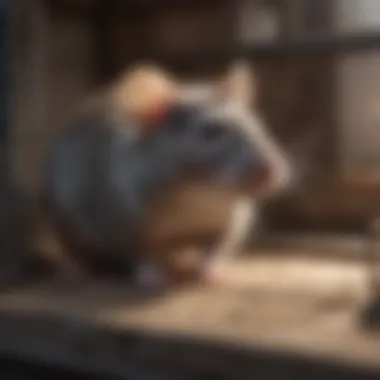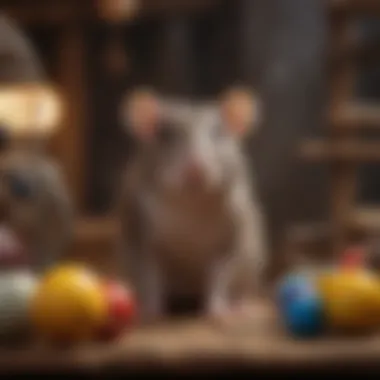Finding the Best Rat Cage for Two Rats: Expert Insights


Intro
Choosing a rat cage is not a small decision. Rats are social, intelligent creatures that require careful consideration when selecting their habitat. This guide serves as a blueprint to help you navigate through the complexities of finding the best rat cage for two rats. As you make your choice, understanding your pets, their needs, and how the cage contributes to their well-being becomes crucial.
Understanding Your Pet
Pet Behavior Basics
Rats exhibit distinct social behaviors. They thrive in groups and establish complex social hierarchies within their community. When housed together, they engage in grooming and playing, which are vital for their mental and emotional health. It is important to observe how your two rats interact with each other, as this can inform your choice of a suitable cage.
Common Breed Characteristics
Different breeds of rats may have varying characteristics. For instance, Dumbo rats have large ears and often display a more laid-back temperament, while Hooded rats are known for being playful and curious. Understanding these traits helps in selecting a cage that meets their specific needs. You should also consider that larger breeds like the Rex may require more space to move comfortably.
Species-Specific Needs
Rats have specific environmental needs. They require a multi-level cage to encourage climbing and exploration. Adequate ventilation is essential, as it helps prevent respiratory issues. Additionally, considering bedding materials is important. Paper-based bedding is often preferred because it is absorbent and safe for these animals.
Pet Care and Maintenance
Feeding Guidelines
A balanced diet is essential for the health of your rats. Commercial rat pellets should form the basis of their diet. Fresh fruits and vegetables can complement pellets but be sure to avoid toxic foods like chocolate and citrus. Proper nutrition supports their active lifestyles.
Grooming Essentials
Rats do not require extensive grooming, but occasional brushing helps. This is especially true for long-haired breeds. Additionally, regular nail trimming is crucial to prevent injury.
Hygiene Practices
Maintaining a clean habitat is vital for your rats' health. Spot clean the cage daily to remove waste and uneaten food. A thorough cage cleaning should occur every week to keep the environment fresh. Use mild, unscented cleaners to avoid irritating your pets.
Training and Development
Basic Commands and Skills
Training your rats can be rewarding. Teaching basic commands, like
Prologue to Rat Housing
Selecting a suitable cage for two rats is a crucial decision for pet owners. It influences not only the comfort and well-being of the animals but also their behavior and social interactions. An adequate cage serves as the foundation for a healthy habitat, and understanding the needs of rats is essential.
Understanding Rat Behavior
Rats are social creatures. They thrive in the company of their own kind and exhibit complex behaviors, including playfulness, curiosity, and problem-solving. They are known to engage in social grooming and often develop strong bonds with their peers. Recognizing these behaviors is critical when choosing the right cage. For example, a cage that facilitates play and exploration can reduce boredom and encourage a healthier, more active lifestyle. It's also vital to consider the personalities of the individual rats, as some may be more dominant or shy, influencing the setup of their living space.
Importance of Proper Housing
Proper housing is not just about aesthetics; it significantly affects the physical and mental health of rats. A cage that is too small or lacks stimulating features can lead to stress, aggression, or illness. The right enclosure helps to establish a safe environment where rats can express their natural behaviors. Inadequate housing can bring about detrimental effects, such as obesity and depression. It is important to ensure that the selected cage meets the necessary space and accessibility requirements to facilitate climbing, hiding, and social interactions.


“The environment significantly shapes the well-being of your pets. Understanding their needs is vital.”
Key Features of an Ideal Rat Cage
Choosing the right cage for your rats is crucial for their health and happiness. This section discusses essential features that should be considered when selecting a cage. The well-being of your pets depends on several factors, including size, material, and design. Understanding these elements can guide you in making a thoughtful decision.
Size and Space Requirements
Rats are active and intelligent animals that thrive in spacious environments. The size of the cage is a primary concern. A larger cage offers more room for exploration and play. It is recommended that the cage provides at least 2 cubic feet of space per rat. This space allows for climbing, running, and social interaction, which are vital for their mental stimulation.
Different cage styles have varied dimensions. It's important to consider how many levels the cage has as well. A vertical design can provide more space without occupying a larger footprint on the floor. In addition, the laying out of accessories—such as toys and food—should also contribute to maximizing the use of the available space.
Material Composition
Metal vs.
Plastic The choice between metal and plastic cages can greatly influence the longevity and safety of the habitat. Metal cages are often more durable. They resist chewing better than plastic counterparts, which can be crucial, as rats tend to gnaw on their surroundings. However, metal cages may have a higher price point. They often come with a warranty or guarantee due to their sturdiness.
On the other hand, plastic cages can be lighter and may come in various colors. They tend to be easier to transport and set up. Yet, they may wear down quicker and require replacements more often. The decision boils down to your budget and preference for durability versus convenience.
Non-toxic Materials
When selecting materials, it’s critical to ensure they are non-toxic. Rats are sensitive to chemicals, and harmful materials can affect their health adversely. Using non-toxic and safe materials guarantees a healthy living space. Look for cages made with BPA-free plastic and powder-coated metal. These materials minimize risks associated with harmful exposure while ensuring rats’ comfort.
Using non-toxic materials is beneficial for the environment, as well. Many brands are now focusing on creating eco-friendly cages, ensuring that your purchase is safe for both your pets and the planet.
Ventilation and Airflow
Good ventilation is vital for maintaining a healthy environment within the cage. Proper airflow prevents dampness and odors, which can cause health issues in rats. When shopping for a cage, ensure that it has enough open space or mesh. This setup enables air to circulate effectively while keeping your pets secure. Consider cages that have larger gaps in the design for optimal airflow, as stagnant air can lead to respiratory issues.
Cage Design and Layout
Multiple Levels
Cages with multiple levels are advantageous for rats. They provide vertical space that allows for climbing. This design mimics natural habitats where rats would climb in trees and burrows. Additionally, multi-level cages can offer more enrichment opportunities by allowing for different areas to be designated for various activities, such as sleeping, eating, and playing. It can also symbolize a safer environment, as your rats can choose to retreat to a higher level if situations feel stressful.
However, accessibility can be a concern with multiple levels. If the cage is too high, rats may find it difficult to reach the top levels. Furthermore, larger cages can become cumbersome to clean, so balance is key.
Bar Spacing
Another important feature is the spacing of the bars. Too wide spacing can lead to escape or injury for the rats. A common recommendation is that bars should be spaced about half an inch apart. This distance usually prevents rats from squeezing through or getting stuck. Check the layout for safe entry points and secure latches to make sure your cage is rat-proof.
Accessibility and Ease of Cleaning
A cage that is easy to clean will significantly benefit both the owner and the pets. Look for designs that provide ample entry points. These should allow for easy access to change bedding and clean surfaces effectively. The floor should ideally be removable, making it more straightforward to maintain a hygienic environment. Avoid cages with intricate designs that trap waste or inaccessible chambers. A clean cage is fundamental for the health of your rats, ensuring they live in a safe and neat space.
Specific Recommendations for Rat Cages
Choosing the right rat cage is crucial for providing a safe and comfortable home for your two pets. With numerous options available on the market, it can be overwhelming to decide which cage best suits your needs. This section provides guidance on specific recommendations that cater to various preferences, ensuring you can find a suitable environment for your rats.


Top Rated Models on the Market
When searching for a high-quality rat cage, certain models consistently receive acclaim from pet owners. Key features like size, ventilation, and material composition are often highlighted in reviews. Examples of top-rated cages include the Critter Nation Double Unit and the Ferplast Furet Tower 2. These cages provide ample space and multi-level options for activity and exploration.
- The Critter Nation Double Unit is spacious, featuring multiple floors and removable trays for easy cleaning. Its sturdy construction ensures durability.
- The Ferplast Furet Tower 2 offers a wide design that provides strong airflow, essential for maintaining a healthy environment. This cage also has numerous access points for ease of interaction and care.
Both of these models stand out due to their practicality and design, making them ideal for owners seeking the best for their furry companions.
Budget-Friendly Options
Affordability is a significant consideration when selecting a rat cage. Fortunately, there are options that do not compromise quality. Budget-friendly choices can still provide a suitable space for your rats without straining your finances. The Midwest Critter Nation Single Unit and the Habitrail OVO Loft are commendable for their balance of cost and functionality.
- The Midwest Critter Nation Single Unit is a compact single environment that's great for two rats. It maintains essential features like multiple levels and ease of access, making it ideal for smaller spaces.
- The Habitrail OVO Loft promotes interaction with its unique design and is easy to clean. It's perfect for new owners or those on a budget.
These economical cages allow for a positive living space while being mindful of your budget, ensuring that both you and your pets are satisfied.
Customizable Cages
For those who enjoy hands-on projects, customizable cages offer a chance to tailor your rats’ living environment to their specific needs. These cages can be adjusted in size, layout, and features based on your preferences. Options such as the CNC Rat Cage and DIY Cages can serve as platforms for your creativity.
- CNC Rat Cage can be assembled with modular grids, allowing you to build it to the dimensions that best fit your space. This flexibility can cater to your rats' social behavior, providing more levels as needed.
- DIY Cages involve using materials from home improvement stores, creating a truly individual design. This option provides an experience for owners looking to invest time and effort into their pets' habitat.
Customizable cages allow pet owners to create an engaging experience while ensuring the comfort and activity needs of their rats are met.
Providing a suitable cage is more than just a shelter; it's about promoting a healthy, engaging environment that keeps your pets happy.
Essential Accessories for Rat Cages
Choosing the right accessories for your rat cage is crucial for the well-being and happiness of your pet rats. These accessories not only enhance their living environment but also promote their physical health and mental stimulation. Proper accessories can provide comfort, exercise, and opportunities for social interaction. In this section, we will explore various essential accessories that can significantly improve the living conditions of your rats.
Bedding Material Types
Bedding is a fundamental component of any rat cage. The right bedding can absorb moisture and odors, providing a clean and comfortable space for your pets. Various types of bedding are available, and each has its pros and cons.
- Paper-based bedding: This is often recommended for its absorbency and softness. Brands like Carefresh offer a clean and dust-free option.
- Aspen shavings: This type is safe and provides a natural environment. Aspen is non-toxic and helps control odors effectively.
- Hemp bedding: Known for its absorbency and biodegradability, hemp bedding can be a great choice for eco-conscious pet owners.
- Wood pellets: These are excellent for odor control and absorb moisture well. However, some rats may find them a bit harsh on their feet.
When selecting bedding, it is vital to avoid cedar or pine shavings as these can be harmful to your rats' respiratory systems. Regular changing of bedding is essential for maintaining a healthy habitat.
Toys and Enrichment Items
Rats are highly intelligent animals that require mental and physical stimulation. Providing an array of toys and enrichment items can prevent boredom and encourage natural behaviors, beneficial for their overall health.
- Chew toys: Rats have a natural instinct to gnaw. Wooden chew toys or treats can keep their teeth healthy and trimmed.
- Tunnels and tubes: These encourage exploration and create spots for safe hiding. Plastic or cardboard tubes can provide hours of fun for your rats.
- Climbing structures: As social animals, rats love climbing. Consider adding hammocks or shelves at varying heights within the cage to facilitate exercise.
- Interactive toys: Puzzle toys that dispense treats can stimulate your rats’ minds and reward them for their efforts. These toys encourage problem-solving and can help reduce stress.
Regularly changing or rotating these items will provide fresh challenges and maintain your rats' interest.
Food and Water Bowls
Proper nutrition and hydration are key components in maintaining healthy rats. Selecting the right food and water bowls is essential to ensure that your pets eat and drink comfortably.


- Stainless steel bowls: These are a solid choice as they are durable and easy to clean. Moreover, they do not tip over easily.
- Weighted bowls: Look for bowls that are specifically designed not to spill. This helps keep the cage cleaner and ensures food and water are available at all times.
- Water bottles: Some owners prefer using bottles instead of bowls due to potential spills. Ensure that the bottles are equipped with a sipper tube that does not leak and is easy for the rats to use.
Always monitor your rats' food and water regularly. Fresh water should be available at all times, and food should be replaced daily to maintain freshness and prevent spoilage.
Proper accessories coupled with regular maintenance contribute to a happy and enriching environment for your pet rats.
Enhancing the Living Environment for Rats
Creating a stimulating and comfortable living environment is crucial for rats. As intelligent and social creatures, their well-being relies on more than just food and water. Enriching their habitat can significantly improve their quality of life. This section will explore how to enhance the living conditions for your pet rats by focusing on two primary aspects: creating a natural habitat and addressing their social interaction needs.
Creating a Natural Habitat
A natural habitat closely mimics the environment rats would experience in the wild. Ensuring that your rats feel safe and engaged can mitigate stress and behavioral issues. Here are some essential elements to consider in creating their habitat:
- Space Utilization: The cage should offer ample space for exploration. Incorporating different levels can encourage climbing, which is a natural behavior for rats.
- Hiding Spots: Adding tunnels, boxes, or hammocks provides places for your rats to retreat when they need downtime. This can help reduce anxiety and increase their overall comfort.
- Natural Materials: Use natural materials like wood and cardboard for toys and structures. Avoid plastic items that can be harmful when chewed. Natural elements better reflect a rat's instinctual behaviors.
- Environmental Enrichment: Introduce varying textures and scents. Items like hay, soft bedding, or even non-toxic plants can create a more dynamic environment.
By implementing these features, you can encourage exploration and play. Rats thrive when their surroundings resemble their natural habitats. More interactivity enhances their mental health and keeps them physically active.
Social Interaction Needs
Rats are inherently social animals and require interaction with one another. Having at least two rats together is vital for their social development. Here are some insights into their social needs and how to foster them:
- Companionship: When kept alone, rats can experience loneliness. They often bond closely with their cage mate, reducing stress and promoting healthier behavior.
- Interactive Play: Schedule regular playtime outside of the cage. This allows rats to engage with each other and their environment. Consider using toys that promote cooperation, like tunnels or balls.
- Routine: Establishing a daily routine for feeding and interaction can help your rats feel secure. Consistency can reduce anxiety and improve their overall mood.
- Observing Interactions: Watch how your rats interact. Some may form hierarchies or prefer certain activities. Understanding their social dynamics can help you better cater to their needs.
Creating an enriching environment that meets both the physical and social needs of your rats ensures a happy, healthy life. These measures not only enhance their well-being but also strengthen the bond between pets and their owners.
By paying attention to these aspects, you can provide the best care for your furry friends. The ultimate goal is to create a space where your rats can express their natural behaviors and live harmoniously.
Maintenance and Care of Rat Cages
Maintaining a clean and healthy environment for rats is crucial. Proper care ensures their well-being and prevents health issues. A neglected cage can lead to stress and illness in your pets. Therefore, embracing a routine that balances cleanliness and monitoring is necessary. In this section, we will explore practical cleaning protocols and tips for identifying potential health problems with your rats.
Routine Cleaning Protocols
Establishing a cleaning routine is fundamental for a rat cage's maintenance. Consider the following protocols:
- Daily Spot Cleaning: Remove soiled bedding and uneaten food from the cage daily. This reduces odors and discourages bacterial growth. Use a small scoop or a dustpan to collect waste.
- Weekly Deep Cleaning: At least once a week, perform a thorough cleaning. Disassemble the cage and wash all components with mild, non-toxic soap. Rinse thoroughly to eliminate any residue. Pay special attention to corners where waste may accumulate.
- Bedding Replacement: Regularly replace bedding material, ideally weekly, to keep odor under control. Choose absorbent and soft materials like paper-based bedding or aspen shavings.
- Sanitizing: After washing the cage, sanitize surfaces with a vinegar and water solution. This natural solution effectively eliminates bacteria without harmful chemicals. Allow surfaces to dry completely before reassembling the cage.
Incorporating these practices results in a safe and pleasant environment for your rats. They will feel more at ease in a clean space, contributing to their overall happiness.
Monitoring for Health Issues
Keeping an eye on your rats’ health is as important as routine cleaning. Here are some key indicators to watch for:
- Behavioral Changes: Sudden changes in activity level or social behavior can signal health problems. If your rats are less playful or withdrawn, it might warrant further investigation.
- Physical Symptoms: Look for signs like discharge from the eyes or nose, difficulty breathing, or irregular eating habits. These symptoms often indicate underlying health issues.
- Weight Monitoring: Regularly weigh your rats to ensure they maintain a healthy weight. Sudden weight loss or gain can be a sign of medical issues.
- Clean Environment: A clean cage can help minimize health problems. However, if you notice persistent foul odors even after cleaning, it may indicate a larger problem.
Regular monitoring enhances your understanding of your rats' health needs. By staying observant, you can address any concerns promptly.
End
Making the Final Decision
When choosing a cage, consider the specific needs of your rats. Look for a cage that meets the requirements outlined in this guide. Review options that provide ample space, quality materials, and appropriate ventilation. Take the time to compare models and read customer reviews to determine which product best suits your requirements. One advantage of high-quality cages is increased durability. Investing in a solid choice will save you money and effort in the long run.
Investing in Quality for Long-term Benefits
Selecting a top-quality cage is not just about meeting initial expectations. Good cages last longer and provide better safety for your rats. They often come with added features that enhance your pet's experience. Quality cages tend to be easier to maintain, requiring less frequent replacements and repairs. Furthermore, a well-designed cage can significantly improve your rats' well-being, ensuring they have a safe and enjoyable space to thrive. In summary, prioritizing quality in your choice can lead to a healthier and happier life for your pets, providing greater satisfaction for you as an owner.







